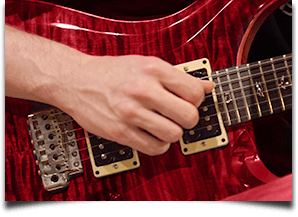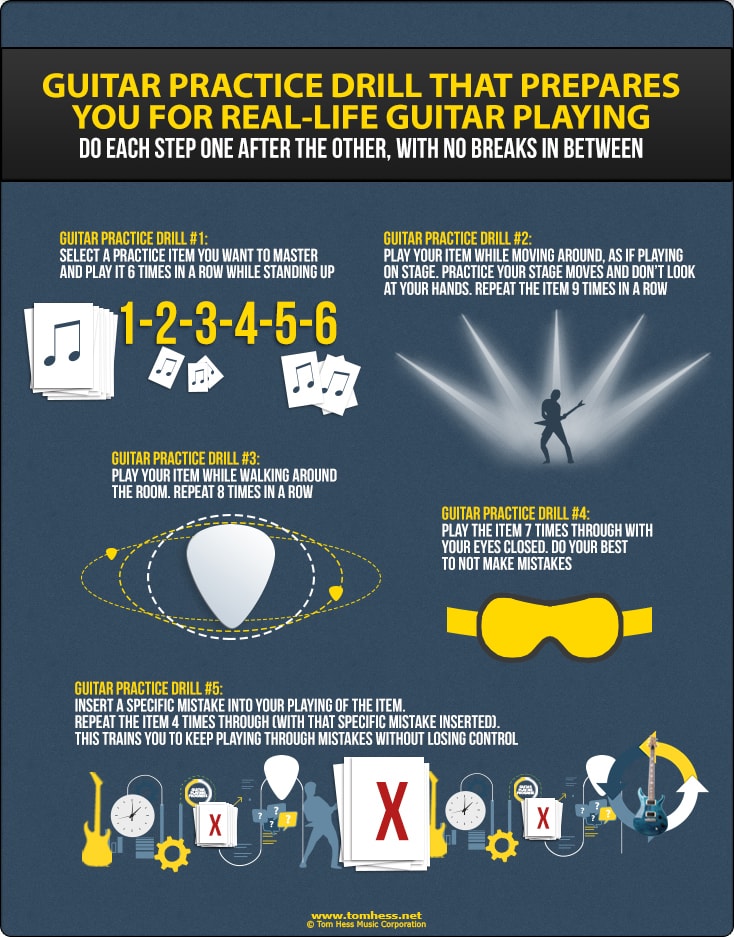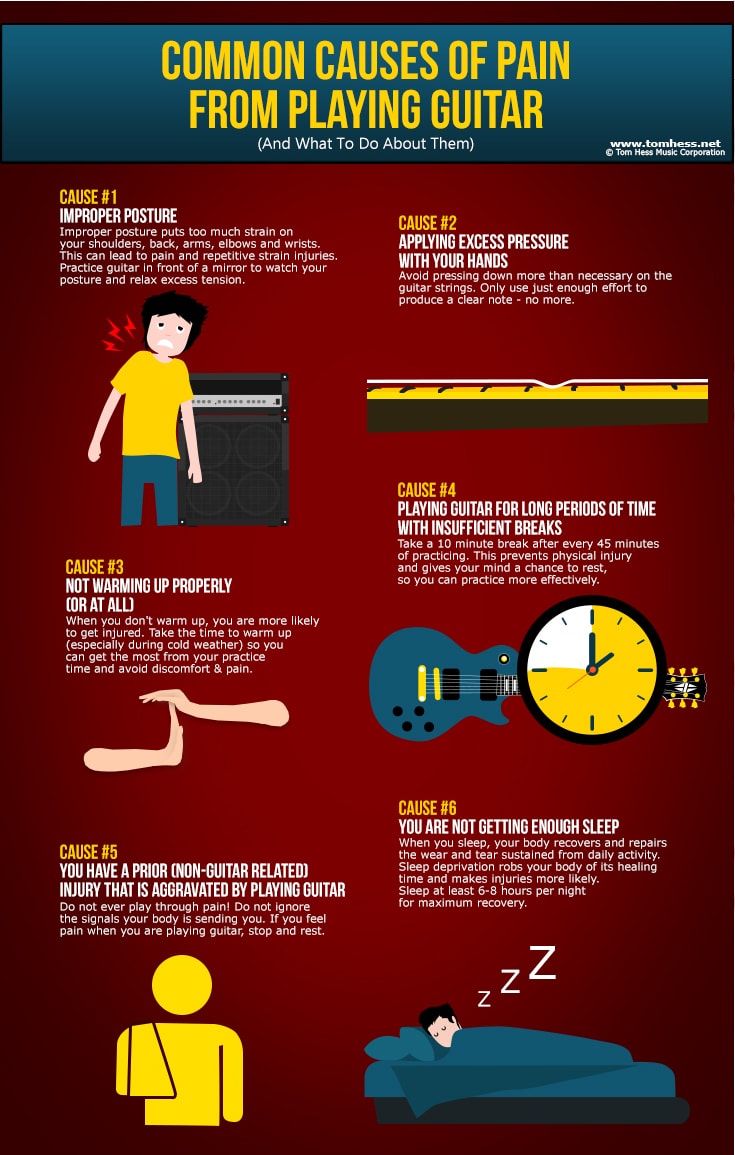How To Play Killer Metal Rhythm Guitar
by Tom Hess
Hearing Rhythm Guitar Flaws

By submitting your info, you agree to send it to Tom Hess Music Corporation who will process and use it according to their privacy policy.
Want to impress others (and yourself) with your rhythm guitar riffs?
It's not hard.
(And it's a lot of fun too.)
Here is what to do:
Stop looking for “cool guitar riffs” to play.
Instead: practice to make your playing very tight.
When your playing is tight – any riff you play sounds good.
Hearing Rhythm Guitar Flaws

By submitting your info, you agree to send it to Tom Hess Music Corporation who will process and use it according to their privacy policy.
Always.
On the other hand:
Sloppy rhythm playing doesn’t impress anyone.
(No matter what you play or how fast you play.)
Tight playing is about 3 things: timing, palm muting control and consistency.
Want to hear the (huge) difference between tight and sloppy rhythm playing?
Watch the video & and then practice the drills below:
Ready to make your rhythm playing tight? It’s simple.
Do these 5 things every day:
Many rhythm guitarists use too little power in their picking hand. They think that playing fast is about picking lightly.
This creates a big problem:
…it makes your playing sound wimpy.
To play fast and powerful rhythm guitar riffs (without becoming tired) you need 2 things:
- Hit the strings hard.
- Relax the tension in your picking hand (and arm) afterplaying each note or chord.
(I show you how to do this below.)
Watch this video to see how to play powerful rhythm guitar riffs:
Tip: you can use powerful pick attack without hitting the strings very hard. You can also dig the pick deeper into the string trench.
(The string trench is the space between strings.)
Digging the pick deeper between the strings makes your pick attack louder without extra effort.
Another tip is to use downstrokes whenever possible. This makes your picking more aggressive and articulate at any speed.
(Bonus tip: practice your riffs with all upstrokes to make your downstroke speed faster.)
Question: “But Tom Hess, what if I can’t relax tension in my arm while playing? My hand seems to have a mind of its own.”
Answer: Excess tension doesn’t simply happen. It happens because your brain is telling your hand to become tense. (This might happen subconsciously without you noticing.)
This also means your brain can start sending a different command to your hands - to relax between notes.
Watch this video to see how to do this:
Re-training your muscle memory may take time, but it’s simple to do. All it takes is patience and lots of perfect repetitions of correct motions.
Most rhythm guitarists know they need to practice with a metronome.
Problem is:
Metronome practice is only one element of tight rhythm guitar playing.
Other elements include:
- Playing with perfect intonation on all strings when you strum chords. This becomes most important when you record rhythm guitar parts in the studio.
- Eliminating ringing noises from strings that you are not playing.
- Eliminating unwanted squeaks or scratchy noises when you change chords.
- Muting strings that are not part of the riff (or chord) you are playing.
- Avoiding sloppy noises during rests in the music (between notes/chords).
- Playing pinch harmonics with vibrato that matches the rhythm of the music.
- Doing all of the items in this list with rock-solid timing.
Master rhythm guitarists developed these elements to a very high level. You can do the same.
How?
Simply make time & practice the elements in the list I just gave you.
Note: one of the keys to rhythm guitar mastery is hearing the difference between truly tight rhythm guitar playing and playing that is not very tight.
How well can you do this now? Test yourself in this rhythm guitar skills assessment.
If you don’t already know how to correctly practice these elements of tight rhythm guitar playing, get a good teacher to help you.
 How To Play Awesome Guitar Riffs
How To Play Awesome Guitar RiffsFind out how to play killer rhythm
guitar riffs in a rock/metal style.
 10 Ways To Improve As A Guitarist
10 Ways To Improve As A GuitaristLearn 10 things that will help you quickly become a better guitarist.
 Learn What To Practice On Guitar
Learn What To Practice On GuitarLearn how to become a balanced
guitarist and fix your weaknesses.
Question: “Tom Hess, that is A LOT of stuff to focus on! What’s the best way to keep track of all these elements in my head while practicing?”
Answer: Use focus rotation. That means select one of these elements to focus on for 30-60 seconds. After 30-60 seconds, rotate your focus and pay attention to the next element.
Keep going for 10-15 minutes.
This is how you practice all elements of tight palm muting without overloading your brain with more than it can handle :)
Extra Tip:
You can use focus rotation on ALL areas of your guitar playing (rhythm and lead).
This is one of the fastest ways to improve and enjoy practicing guitar.
Do you only intend to play guitar for yourself?
I didn’t think so.
In that case:
…You need to make your rhythm guitar playing reliable when playing in front of others (and/or in the studio).
Playing by yourself (and for yourself) is one thing.
Playing for real (in front of other people) is another thing.
Why don’t more guitarists practice for real-life playing?
That is because:
- They never had a great guitar teacher show them how to do this correctly.
- They assume that their real-life playing skills will “develop on their own” as they simply play guitar more. (This almost never happens.)
Want to learn how to practice rhythm guitar to prepare for real-life playing? Read this article about playing guitar live.

Question: “Tom Hess, I tend to feel more tension all throughout my body when I play live. How can I relax it?”
Answer: Put yourself under stress more often :) The more often you play in front of people, the more comfortable you become.
Extra tip: playing in front of 1-2 people is much more stressful than playing in front of a group of people. (This is especially true if those 1-2 people are good guitar players or guitar teachers.)
When you can stay relaxed in that situation, you have more control over excess muscle tension than most guitar players in the world :)
A common rhythm guitar mistake is to tense up your fretting hand as your picking hand plays faster.
Why is it so bad?
This tension makes you tired quickly and playing fast rhythm guitar riffs becomes a real struggle.
What is the solution?
Mentally separate the hands when you practice rhythm guitar.
This means:
Don’t let your fretting hand squeeze the strings harder as the picking hand strums the strings.
Your fretting hand needs a whole lot less power and strength to fret notes than the picking hand does to strum chords.
The more you pay attention to tension levels in your body, the better your entire guitar playing becomes.
Rotate your focus when practicing and make sure that each hand uses appropriate amounts of tension for the job it has to do.
Question: “But Tom Hess, what if my fretting hand tenses up when I use more power in my picking hand? How can I avoid this?”
Answer: Simple:
Play just one chord with your fretting hand and alternate between strumming it softly and aggressively. When you strum, focus on your fretting hand.
Your level of tension in the fretting hand should not change – whether you strum softly or very aggressively.
If this is difficult to do – play slower.
Remember:
You can get your hands to do anything you want when you play slowly enough.
Bonus tip:
Find a base line level of tension.
This means:
Relax your fretting hand until you can’t play clear sounding notes anymore.
Then add just a bit more effort to get the notes to sound clear.
This is the base level of tension to use in your fretting hand (no matter how aggressively you strum with your picking hand).
Watch this video to see how to do it:
Rhythm guitar endurance consists of 3 things:
- Control over general rhythm guitar tightness and accuracy (the elements I listed earlier in this article).
- The speed at which you can play perfectly.
- The amount of time you can maintain control, accuracy & tightness at that speed.
Training for rhythm guitar endurance is best done on 2 different levels:
Level 1: Select a guitar riff that you want to build endurance with. Then set a time goal (how long you want to play the riff at that tempo). Next, find the fastest tempo where you can play your riff perfectly for the desired amount of time.
For example:
Play your guitar riff for 30 seconds non-stop at 100 beats per minute on the metronome.
Then (if it feels too easy), increase the metronome by a few beats per minute and repeat the process for another 30 seconds.
Continue doing this until you hit a metronome tempo where your playing falls apart (before you can play for 30 seconds).
Keep practicing at that tempo, until you can play your riff accurately and tight for 30 seconds.
Level 2: Select a metronome tempo and try to play your rhythm guitar riff for as long as possible at that speed. When you are able to beat your previous time (play longer than you have in the past), your endurance has improved.
Combining these 2 approaches helps you fully master this area of rhythm guitar playing.
These endurance-training methods are similar to building endurance in sports.
This means:
Just like sports: If you ever feel pain while practicing guitar, this is a sign to STOP. NEVER attempt to play through pain!

Now that you know what to practice to become a great rhythm guitar player, test yourself to see how close you are to mastering rhythm playing.
Take this guitar playing assessment & learn exactly what to work on to transform your rhythm playing into something you feel proud of.
 About Tom Hess: Tom Hess is a guitar teacher, music career mentor and guitar teacher trainer. He teaches rock guitar lessons online to students from all over the world and conducts instructional live guitar training events attended by musicians from over 50 countries.
About Tom Hess: Tom Hess is a guitar teacher, music career mentor and guitar teacher trainer. He teaches rock guitar lessons online to students from all over the world and conducts instructional live guitar training events attended by musicians from over 50 countries.

Forward this article to your friends

